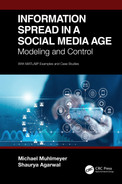Index
advertising, 7, 139, 211, 212, 215, 217
social media, 140, 211, 212, 215, 226
analog models, 93
approximations, 63, 64, 66, 67
environmental, 63
operational, 63
people, 63
balanced relationships, 38, 234
basic reproductive number, 90, 101
boundary value problem, 215, 225
Brownian motion, 130
social marketing, 212
case studies, 156–158, 161–168, 170, 171, 173–178
selection of, 154
centrality, 46
closeness, 48
degree, 47
network, 47
cliques, 51
cohesion, 51
compensator, 192
conceptual model, 66
connectedness, 86
connectedness factor, 94
context-aware modeling, 108
control, 9, 64, 205, 207, 234, 235
optimal, 193
control action, 69, 185, 190, 207, 213, 216, 223
in social media, 207
control objective, 189, 190, 223–227
applications, 183
closed-loop, 184, 185, 190–192
MIMO, 184–186
open-loop, 184
controller, 192
derivative, 193
integral, 193
proportional, 193
COVID-19, 6
curve flattening, 91
data acquisition, 61, 67, 158, 164, 168, 174, 234, 235
decay, 106, 171, 212, 216, 226
diffusion, 80
diffusion effect, 80
disinformation, 8, 222, 223, 225–227
distance, 48
geodesic, 48
electrical system, 74
epidemic models, 85, 86, 89, 93
curve flattening, 91
evaluation tests, 66
external subsystems, 204
fake news, 8, 222, 223, 225–227
control, 190
full-state controller, 190
filter bubbles, 36, 41, 51, 234
Golden Globe Awards, 167, 168, 170, 171
Google Trends, 154
Hamilton-Jacobi-Bellman (HJB) equation, 195–197, 202, 213, 214
Hamiltonian, 196, 213, 214, 224
herd immunity, 90–92, 101–103, 222
history of information spread
ancient, 26
contemporary, 28
early modern, 27
medieval, 26
homogeneous groups, 65
hybrid ISCR model, 115
infected, 75
infection constant, 75
infectious, 86
information
categories, 2
contentious, 4
controllable, 9
factual, 3
opinion-based, 3
social exchange theory, 29
theory of spread, 29
information epidemic threshold, 225
information spread
analog models, 93
contentious, 107–109, 113, 117, 119
model conventions, 94
parameters, 94
scenarios, 5
variables, 94
interdisciplinary approach, 28
intermediary relationships, 34
IS model, 95
ISCR model, 107–109, 113, 117, 119, 174, 176
ISI model, 97
ISR model, 99, 103, 106, 171, 222, 223
linear independence, 69
linear parameterization, 159
linear systems theory, 184
Maki-Thomson model, 99
mass communication, 6
mass panic, 6
mass shootings, 156–159, 161, 162
matrix
feedthrough or feedforward, 69
input, 69
output, 69
system, 69
mechanical system, 74
misinformation, 4, 8, 222, 223, 225–227, 236
key steps, 66
objectives, 66
models, 236
agent-based, 64
Bass, 142
Daley-Kendall, 30
data and learning based, 61
definition, 59
engineering, 61
epidemic, 74, 75, 85, 86, 89, 93, 234, 235
event-triggered social media chatter, 144–146, 207, 208, 212
hybrid ISCR, 115
in decision making, 60
IS, 95
ISCR, 107–109, 113, 117, 119, 174, 176
ISR, 99, 103, 106, 135, 171, 222, 223
Lighthill-Whitham-Richards, 77
macroscopic, 65, 146, 205, 235
physical, 61
schematic, 61
science, 61
Sethi, 142–144
stochastic, 132, 133, 135, 234
multidisciplinary approach, 28
necessary conditions, 214
network
optimal control, 193–197, 202, 213
in social media, 208
theory, 197
output equation, 69
parameter estimation, 159, 160, 165, 170, 176
philosophy
deductive reasoning, 26
inductive reasoning, 26
Pontryagin’s minimization principle, 195, 196, 202, 213, 214, 224
reconstruction algorithm, 168, 170
recovery constant, 75
recovery rate, 86
regulation problem, 190
reproduction number R0, 89, 90
rumors, 8
scientific method, 26
scraper, 159
scraping, 158
sensitivity tests, 66
SIR model, 86
small world networks, 48–50, 234
social exchange theory, 29–31
social media
blogs, 19
discussion forums, 19
games and music, 21
hybrid, 21
memes, 22
shopping, 20
social sharing, 18
social media chatter, 144–146, 212, 213
social media models
hybrid ISCR, 115
social media network theory
social exchange theory, 30, 31
social movements, 163–167, 212
social network relationships
complex networks, 35
core relationships, 34
Facebook, 17
LinkedIn, 18
social reinforcement, 30
social subsystems, 203
social theory, 29
qualitative, 30
socio-equilibrium threshold, 146, 147, 213, 215, 217
socio-techincal systems, 203–206, 236
socio-technical systems, 204
of a club, 53
software, 39
Sorger approximation, 143
spreading rate, 86
spring-mass system, 70, 71, 186
state equation, 69
state variables, 190
state-space representation, 68, 69
stochastic ISI model, 133, 134
stochastic ISR model, 135
stochastic modeling, 132
stochastic models, 131
stochastic processes, 130, 131
stochastic realization, 131
structural holes, 45
symmetry, 34
systems, 183
balanced, 76
behavior, 183
dynamics, 69
mathematical, 67
modeling of, 64
technical subsystems, 203
tracking problem, 191
trends, 154
variables
output, 69
vector
control, 69
output, 69
state, 69
viral internet debates, 173–178
